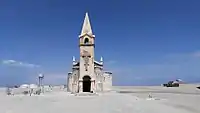Saint Martin of the Tigers
Saint Martin of the Tigers (Portuguese: São Martinho dos Tigres), sometimes referred to simply as Village of Tigres Bay (Portuguese: Vila da Baía dos Tigres), is a ghost town[1] in southern Angola, located on Tigres Island, currently separated from the Angolan mainland by the Tigres Strait. For legal purposes it is also a commune in the municipality of Tômbua, in the province of Namibe.[2]

It was founded in 1860 as a model settlement town to serve as a population and economic center in one of the most inhospitable regions of the Namibe desert. The Portuguese colonial government sent many inhabitants of the Algarve, with great experience in sea fishing, to found the village of Saint Martin of the Tigers, in the still existing Tigres bay.[3]
The village had great infrastructure, having become the largest Angolan fishing center before the first half of the 20th century. However, in 1962, strong waves broke the isthmus of the Tigres peninsula, making it the current Tigres Island. Thereafter Saint Martin of the Tigers faced many difficulties, suffering problems with the supply of water, food and basic items.[4]
Between 1975 and 1976, given that the majority of its population was of European descent and, fearing reprisals from nationalist movements in the ongoing civil war, the village was abandoned, never being populated again for long periods. In the 1980s and 1990s the Angolan government tried to encourage waves of migration to repopulate the village, but was unsuccessful.[4]
Even so, from 1996 onwards, the Angolan government figuratively appointed the communal administrator of Saint Martin of the Tigers, elaborating an ambitious project to recover the locality and the valuable fishing center.[5] The European Union has come to foresee support, but the town's recovery has not yet started. The economic activity that still develops in the area is tourism, thanks to the popular legends that emerged after its transformation into a ghost town.[6]
References
- Bump, Philip (20 April 2017). "The farthest place on Earth from the Trump brand? A ghost town on a desert island". The Washington Post. Archived from the original on 28 February 2023. Retrieved 22 June 2021.
- "Comunas". Ministério da Administração do Território e Reforma do Estado (in Portuguese). 2018. Archived from the original on 12 February 2020.
- Azevedo, José Manuel de (2014). A colonização do Sudoeste Angolano: Do deserto do Namibe ao planalto da Huíla, 1849-1900 (PDF) (Doctoral thesis) (in Portuguese). Universidad de Salamanca.
- Cardoso, Pedro (22 September 2016). "Tômbua". Rede Angola (in Portuguese). Archived from the original on 2 October 2021.
- Julião, Paulo (10 January 2019). "Baía dos Tigres é uma aldeia fantasma". Jornal de Angola (in Portuguese). Archived from the original on 16 February 2020.
- "A Baía dos Tigres é uma vila fantasma com administrador ausente". Público (in Portuguese). Lusa. 24 April 2018. Archived from the original on 3 October 2021.